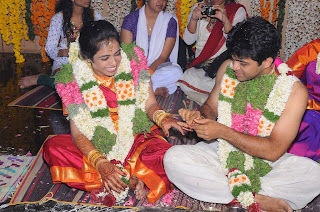 |
| A gramophone and (below) a plate. Pictures courtesy Internet. |
Those were the days when people were unaware of things like electricity and running water at homes. No electricity means none of the modern conveniences one has today. The gramophone was the only luxury some homes could boast of, and ours was one of those. We had collected a large number of plates -- this was what records were referred to in those days. This gramophone was operated by hand, winding up the springs that make the record holder revolve, fixing the needle to the stylus (one had to change the needle after the first side was played, to play the other side) We children were not allowed anywhere near this. Not only that we, the youngsters had to beg and nag our elder brother to operate this for us whenever we felt like listening to our favourite songs.
My favourite list included one song which begins with the words, ‘Kazhuku malai Kuruvi kulam’(Eagle Mountain Sparrow Pond) - a song with two stanzas. Even after so many years I felt happy when I found out I remembered the words. The song on the flip side of this record was very rustic, beginning , “Macha vandhidingo thirunalluku” (An invitation to the boy friend to attend a festival).These were not film songs but common “Theru koothu” (street play) songs. As I write, so many of those songs come flooding into my memory. “Indru pole endrum namum Isan namam Pottuvome” (Let us ever sing the praise of Isan the Lord); “Imayam muthal Kumari varai” (from the Himalayas to Kanya Kumari) - this song gave a geographical description of India
These records were pushed back to the bottom shelf when songs of films like Chintamani, ThyagaBhoomi Seva Sadanam, Sakuntala,Balayogini and Bhaktha Kuchela became very popular. We had a few Telugu and Hindi film song records also in our collection. I remember how people on the street would stop in front of our house to listen to the latest film songs played on the gramophone. My elder brother was an avid collector of all film songs because my mother really enjoyed listening to them in the evenings, for though they were film songs all most all of them were devotional ones.
When the radio entered our home in the late 1930s the gramophone and the records were handed down to the youngsters and we felt very grown up when our nephews were at the requesting end, begging us to play their favourite songs
Now today only oldies like me think of these things and some days lose sleep also thinking about those “GOOD OLD DAYS.” My youngest daughter told me once that in everyone’s life there are those Good Old Days depending on their age and when life was smooth running for them easy going, without any care. Reading the write up on Kazhuku Malai gave me so much pleasure, it brought back all those old songs to the front of my mind.
How I wish I could sing them out loud and clear! But that is not possible because I can only sing out of tune which even ‘Bathroom singers’ will object to.



























